|
Thurs., March 15
1:00 p.m.
ALCPG ILC Physics and Detector Seminar - West Wing WH-10NW
Speakers: J. Brau, University of Oregon and H. Weerts, Argonne National Laboratory
Title: The Five Year US Detector R&D Plan
2:30 p.m.
Theoretical Physics Seminar - Curia II
Speaker: N. Arkani-Hamed, Harvard University
Title: Quantum Black Holes and the Standard Model's Landscape
3:30 p.m.
DIRECTOR'S COFFEE BREAK - 2nd Flr X-Over
4:00 p.m.
Accelerator Physics and Technology Seminar - 1 West
Speaker: S. Antipov, Argonne National Laboratory
Title: Metamaterial-Loaded Waveguides for Accelerator Applications
Fri., March 16
3:30 p.m.
DIRECTOR'S COFFEE BREAK - 2nd Flr X-Over
4:00 p.m.
Joint Experimental-Theoretical Physics Seminar - 1 West
Speaker: A. Meyer, RWTH, Aachen
Title: DZero Results on Searches for New Phenomena
Sat., March 17
8:00 p.m.
Ensemble Lucidarium - Auditorium
Tickets: $10/$5
More information
Click here for NALCAL,
a weekly calendar with links to additional information. |
Thursday, March 15
-Tomato florentine
-Grilled chicken cordon bleu sandwich
-Chimichangas
-Smart cuisine: Chicken marsala
-Smoked turkey melt
-Assorted slice pizza
-Southwest chicken salad with roasted corn salsa
Wilson Hall Cafe Menu |
|
Thursday, March 15
Dinner
-Fontina and Prosciutto Crepes
-Scampi with Fettuccine
-Apricot Tart
Wednesday, March 21
Lunch
-Saucisson en croute w/madeira sauce
-Salad of field greens w/mustard vinaigrette
-Amaretto chocolate cheesecake
Chez Leon Menu
Call x4598 to make your reservation. |
|
|
Giant black holes present
a mass and time dilemma
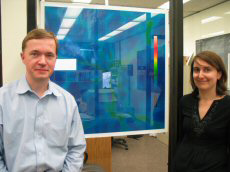
Nick Gnedin and Robyn Levine use supercomputers to model black hole formation.
Black holes are presenting cosmologists with a problem: when the universe was at the tender age of one billion years, certain black holes already had the mass of three billion suns. "It's just very difficult to understand how these black holes formed so quickly," said Nick Gnedin, of PPD-Theoretical Astrophysics and the University of Chicago. "We know they exist, we just don't know how."
The energy from one average black hole could power all of human civilization for billions of years. Supermassive black holes -- the big ones that became powerful at a young age -- have up to a billion times that energy. "The big ones are ridiculously bright and ridiculously powerful," said Gnedin. "Because they are so bright, you can see them very, very far away, equivalent to the time when the universe was very young." Even though light travels quickly, the supermassive black holes that Gnedin studies are so far away that their light takes 12.5 billion years to reach to reach our eyes.
But black holes don't grow overnight. They get bigger when their gravity sucks in nearby matter, and that process takes time. "If supermassive black holes form by merging smaller objects together, or during galaxy mergers, that can take awhile," said Gnedin's colleague, Robyn Levine of the University of Colorado at Boulder. To explain how something so huge could be created by such a young universe, Gnedin and Levine develop computer models. "The advantage of using models is that we can actually watch things change in front of our eyes and see how things take shape," said Gnedin. Starting with data from the beginning of the universe (gained from WMAP), Gnedin and Levine plug in equations to represent physical forces. A supercomputer solves the equations to show how the universe should look over time. "We are at the point where we can compare what happens in our model to observations of the universe, and a number of features seem to be agreeing with what the black holes look like," said Gnedin. "Now we just have to explain why this happens in our model---and in the universe."
See images from Nick Gnedin's simulation gallery.
--Siri Steiner
|
|
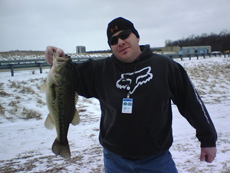
Derek Plant took this photo of Bill Dymond catching a bass in the Main Injector pond. on March 3. "Work is done for the day, it's 26 degrees outside, and six casts lands a four-and-a-half pound largemouth bass," Bill wrote. "That's priceless." This is the third bass over four pounds that Bill has caught this year.
|
Counting the Clouds

Like digital photographs, atmospheric models need high resolution to ensure accuracy.
Zoom in too closely on a digital photo and the image will be hard to see. To view the image closely you will need a higher resolution.
When meteorologists model atmospheric conditions, the forecast they create is a kind of photograh made of 'pixels' as well. For climate models, such as ECHAM5, used widely in Europe, these 'pixels' are columns of air approximately 1 kilometer thick (vertically) and 250 by 250 kilometers wide (horizontally). Anything smaller than the pixel size, cumulus clouds a few kilometers wide for example, are not in resolution.
Read More
|
Physorg.com, March 12, 2007:
Physicists Modify Double-Slit Experiment to Confirm Einstein's Belief
Work completed by physics professors at Rowan University shows that light is made of particles and waves, a finding that refutes a common belief held for about 80 years.
Shahriar S. Afshar, the visiting professor who is currently at Boston's Institute for Radiation-Induced Mass Studies (IRIMS), led a team, including Rowan physics professors Drs. Eduardo Flores and Ernst Knoesel and student Keith McDonald, that proved Afshar's original claims, which were based on a series of experiments he had conducted several years ago.
An article on the work titled "Paradox in Wave-Particle Duality" recently published in Foundations of Physics, a prestigious, refereed academic journal, supports Albert Einstein's long-debated belief that quantum physics is incomplete. For eight decades the scientific community generally had supported Niels Bohr's ideas commonly known as the Copenhagen Interpretation of Quantum Mechanics. In 1927, in his "Principle of Complementarity," he asserted that in any experiment light shows only one aspect at a time, either it behaves as a wave or as a particle....
Read More |
|
|
The black orchids
within particle physics
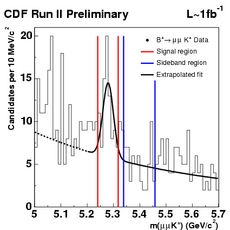
Yield as a function of the invariant mass of the decay products for one of the rare B decay modes in the CDF analysis. See description below.
Throughout history, rarity has been prized. From South Sea Pearls to Black Orchids, nature's rarest specimens have always fetched the highest prices. Nature's rare events are often prized for their unique potential for knowledge. Particle physics, too, has its share of such "one in a million" events.
At Fermilab, protons and antiprotons circulate underground, colliding at two interaction points with a multitude of possible outcomes. One collision in 10,000 produces a particle-- composed of a b quark and one or two other quarks -- called a b hadron, which subsequently decays in surrounding detectors. At CDF, physicists have looked for decays that are expected to occur literally only one in a million of these b hadron decays. These decays owe their rarity to their complex origins. They arise via special decays called "loops." In a loop, a particle decays through the fleeting existence of a heavier virtual particle. Such loops provide a bridge between the real particles seen in the decay and the heavy particles that make the decay possible.
The reason these loop decays are interesting is that some of these heavy particles may not yet have been discovered such as hypothesized supersymmetric particles. By measuring the rate and properties of certain decays, physicists gain a window to view possible exotic particles which experiments have not detected directly. CDF physicists have found the rates of these decays agree so far with Standard Model predictions, but they have caught a glimpse of a rare decay of a b hadron not measured before. With more data these rare decays will be studied even more thoroughly, and who knows what might be hiding in those loops?
Learn more
Above graphic: The black line is superimposed to illustrate the expected signal width and the background extrapolation from the upper mass region (the function is extracted from large control samples). Below the B mass peak we expect an excess due to partially reconstructed B decays.
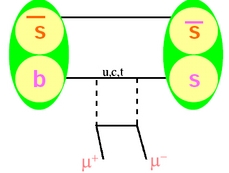
Above: How a loop works: in this diagram, a b hadron composed of a b quark and an anti-s quark decays into a hadron with an s quark and anti-s quark. The loop is the box protruding from the b to s line, which also shows two muons emitted in the process. The loop contains virtual particles u, c, and t quarks, as well as potentially new exotic particles that can change the expected rate and properties of this process. Below: Searching for rare physics: Sinead Farrington (Liverpool), Rolf Oldeman (Liverpool, now Cagliari).
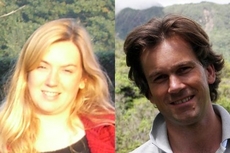
|
|
Mother's room opening
An open house for the Fermilab Mother's Room will take place today at 10 a.m. on the 9th floor of Wilson Hall, northwest side. New and expecting mothers are encouraged to attend and see the room. Punch and cookies will be served.
More information
Upcoming class: Cascading style sheets
Introductory - April 10 & 12 (morning only)
This class will help you give your web pages more sophisticated layouts and more elegant text formatting. More information and registration here.
Hatha yoga classes
The next session of yoga classes will run from March 20 to May 8 on Tuesdays at lunchtime in the Auditorium. The cost for the eight-week session is $80.00. Registration can be made through the Recreation Office. A mat is required. A Recreation Facility membership is NOT required.
Muscle Toning class
Muscle Toning classes will be held on Tuesday and Thursday evenings in the exercise room of the Recreation Facility from 5:30 p.m.- 6:30 p.m., March 15 - April 19 (No class Apr. 10). All classes are four weeks at the cost of $32.00. Registration and payment must be made through the Recreation Office. You must be a current Recreation Facility member to participate.
Chicago Blackhawks tickets
Enjoy the thrills of Blackhawks hockey with your family, friends and co-workers at up to 50 percent off regular ticket prices.
Purchase discount tickets to the following games: Blackhawks vs. Kings on March 23 at 7:30 p.m., Blackhawks vs. Flames on March 25 at 2:00 p.m., Blackhawks vs. Oilers on April 1 at 2:00 p.m.
Information, order forms and seating chart are available in the Recreation Office or online.
Upcoming Activities
|
|